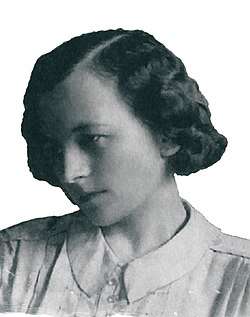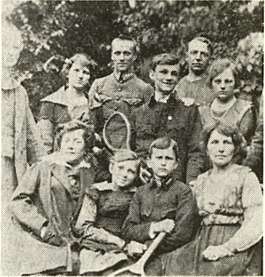Stefania Turkewich
Stefania Turkewich-Lukianovych (April 25, 1898, Lviv, Austria-Hungary – April 8, 1977, Cambridge, United Kingdom) was a Ukrainian composer, pianist, and musicologist, recognized as Ukraine's first woman composer.[1] Her works were banned in Ukraine by the Soviets.
Stefania Turkewich-Lukianovych | |
|---|---|
 | |
| Born | Stefania Turkewich April 25, 1898 |
| Died | April 8, 1977 |
| Education | University of Lviv, Lviv Conservatory, Berlin Conservatory |
| Occupation | |
| Years active | 1920's–1970's |
| Spouse(s) | Robert Lisovskyi; Narcyz Lukianowicz (Нарциз Лукіянович) |
Childhood
Stefania's grandfather (Lev Turkevich), and her father (Ivan Turkevich) were priests. Her mother Sofia Kormoshiv (Кормошів) was a pianist and studied with Karol Mikuli and Vilém Kurz, and also accompanied the young Solomiya Krushelnytska.[2]:7 The whole family was musical and everyone played an instrument. Stefania played piano, harp, and harmonium. Later, the composer remembered her childhood and her love of music:
At the centre of everything was my mother, who played a wonderful piano. As a child, I loved very much to listen to her play. Then, we began a salon orchestra in our home. We played thus: father on the bass …, my mother on the piano, (Льоньо) Lyonyo on cello, me on the harmonium, (Марійка і Зенко) Marika and Zenko … on violins. Father started a family choir as well. These were our first steps into the world of music. Father never skimped on money or made excuses when it came to our musical life.[2]:23
Studies

Stefania began her music studies with Vasyl Barvinsky. From 1914 to 1916, she studied in Vienna as pianist with Vilém Kurz. After World War I, she studied with Adolf Chybiński at the University of Lviv, and also attended his lectures on music theory at the Lviv Conservatory.[2]:10
In 1919 she wrote her first musical work – the Liturgy (Літургію), which was performed several times in St. George's Cathedral in Lviv.[3]
In 1921 she studied with Guido Adler at the University of Vienna and Joseph Marx at the University of Music and Performing Arts Vienna, from which she graduated in 1923 with a Teacher's Diploma.[3]
In 1925 she married Robert Lisovskyi and travelled with him to Berlin where she lived from 1927 to 1930 and studied with Arnold Schoenberg and Franz Schreker.[2]:14 During this period, in 1927, her daughter Zoya (Зоя) was born.[4]
In 1930 she travelled to Prague in Czechoslovakia, studied with Zdeněk Nejedlý at Charles University, and with Otakar Šín at the Prague Conservatory. She also studied composition with Vítězslav Novák at the music academy. In autumn 1933 she taught piano and became an accompanist at the Prague Conservatory. In 1934 she defended her doctoral dissertation on the topic of Ukrainian folklore in Russian operas.[2]:15 She received her doctorate in musicology in 1934 from the Ukrainian Free University in Prague. She became the first woman from Galicia (which was then part of Poland) to receive a Ph.D.
Returning to Lviv, from 1934 until the beginning of the Second World War she worked as a teacher of musical theory and piano at the Lviv Conservatory, and became a member of the Union of Ukrainian Professional Musicians.[3]
World War II
In autumn 1939, after the Soviet occupation of Western Ukraine, Stefania worked as a tutor and a concertmaster at the Lviv Opera House, and from 1940 to 1941 was Associate Professor at the Lviv Conservatory. After the closure of the Conservatory, with the German occupation, she continued teaching at the State Musical School. In spring 1944 she left Lviv for Vienna.[3] Fleeing from the Soviets, in 1946, she moved to southern Austria, and from there to Italy, where her second husband, Nartsiz Lukyanovich, was a physician under the British command.[5]
England
In autumn 1946, Stefania moved to the United Kingdom, and lived in Brighton (1947–1951), London (1951–1952), Barrow Gurney (near Bristol) (1952–1962), Belfast (Northern Ireland) (1962–1973), and Cambridge (from 1973).
In the late 1940s, she returned to composing. From time to time she acted again as a pianist, in particular in 1957 in a series of concerts in Ukrainian communities in England, and in 1959 at a concert of piano music in Bristol. She was a member of the British Society of Women-Composers and Musicians (which existed until 1972).
Her opera Oksana's Heart was performed in Winnipeg (Canada) in 1970 in the Centennial Concert Hall, under the artistic direction of her sister Irena Turkevycz-Martynec.[6]
Centennial Concert Hall – Sunday at 7:30 p.m.: Ukrainian Children’s Theatre presents Heart of Oksana, an opera by Stefania Turkevich-Lukianovich, which is the story of a girl meeting mythological figures in an enchanted forest as she searches for her lost brothers.[7]
Compositions
Симфонічні твори – Symphonic works
1. Симфонія – Symphony no. 1 – 1937
2. Симфонія no. 2(a) – Symphony no. 2(a) – 1952
2. Симфонія no. 2(b) (2-гий варіант) – Symphony no. 2(b) (2nd version)
3. Симфонієта – Symphoniette – 1956
4. Три Симфонічні Ескізи – Three Symphonic Sketches – 3-го травня, 1975
5. Симфонічна поема – Symphonic Poem «La Vitа»
6. Space Symphony – 1972
7. Суіта для подвійного струнного оркестру – Suite for Double String Orchestra
8. Fantasy for Double String Orchestra
Балети – Ballets
9. Руки – The Girl with the Withered Hands – Bristol, 1957
10. Перли – The Necklace
11. Весна (Дитячий балет) – Spring – (Children's Ballet) 1934-5
12. Мавка (a) – Mavka – ‘The Forest Nymph’ – 1964-7 – Belfast
12. Мавка (b) – Mavka – ‘The Forest Nymph’ – 1964-7 – Belfast
13. Страхопуд – Scarecrow – 1976
Опера – Opera
14. Мавка – Mavka – (unfinished) based on Lesia Ukrainka’s Forest Song
Дитячі опери – Children’s Operas
15. «Цар Ох» або Серце Оксани – Tsar Okh or Heart of Oksana – 1960
16. «Куць» – The Young Devil
17. «Яринний городчик» – A Vegetable Plot (1969)
Хорові твори – Choral Works
18. Літургія 1919
19. Psalm to Sheptytsky (Псалом Шептицькому)
20. До Бою
21. Триптих
22. Колискова (А-а, котика нема) 1946
Камерно – Інструментальні твори; Chamber – Instrumental works
23. Соната для скрипки і фортепіано 1935 – Sonata for violin and piano
24. (a) Cтрунний квартет 1960 – 1970 – String quartet
24. (b) Cтрунний квартет 1960 – 1970 – String quartet
25. Тріо для скрипки, альта і віолончела 1960 – 1970 – Trio for Violin, Viola and Cello
26. Квінтет для двох скрипок, альта, віолончела фортепіано 1960 – 1970 – Piano Quintet
27. Тріо для флейти, кларнету, фагота 1972 – Wind Trio
Фортепіанні Твори – Piano Works
28. Варіації на Українську тему 1932 – Variations on a Ukrainian Theme
29. Фантазія: Суїта фортепянна на Українські теми – Fantasia: Suite for Piano on Ukrainian Themes 1940
30. Імпромпту – Impromptu 1962
31. Гротеск – Grotesque 1964
32. Гірська сюїта – Mountain Suite 1966 – 1968
33. Цикл п’єс для дітей – Cycle of Pieces for Children 1936 – 1946
34. Українські коляди та щедрівки – Ukrainian carols and Shchedrivka
35. Вістку голосить – Good Tidings
36. Christmas with Harlequin 1971
Різне – Miscellaneous
- i. – Серце – Heart – Solo voice with orchestra
- ii. – Лорелеї – Lorelei – Narrator, Harmonium and Piano 1919 – words by Lesia Ukrainka
- iii. – Май – May – 1912
- iv. – Тема народної пісні – Folk Song Themes
- v. – На Майдані – Independence Square – piano piece
- vi. – Не піду до леса з конечкамі – Лемківська пісня – Lemky song for voice and strings
Legacy
Her compositions are modern, but recall Ukrainian folksongs when they are not expressionistic. She continued to compose through the 1970s. Stefania Turkevich died on April 8, 1977, in Cambridge, England.
References
- "Ukrainian Art Song Project – Stefania Turkewich".
- Павлишин, Степанія Стефанівна. Перша українська композиторка: Стефанія Туркевич-Лісовська-Лукіянович, БаК, Lviv 2004.
- Роман Кравець. "Українці в Сполученому Королівстві". Інтернет-енциклопедія. Retrieved 2018-08-28.
- "Зоя Робертівна Лісовська-Нижанківська, the Encyclopedia of Modern Ukraine" (in Ukrainian). Retrieved 2018-12-17.
- "Narcyz Lukianowicz (Нарциз Лукіянович)".
- "Svoboda" (PDF).
- Winnipeg Free Press, June 6, 1970
Bibliography
- Сокіл-Рудницька М. Пам’яті Стефанії Лукіянович // Вільне Слово. – Торонто, 1977. – 9 і 16 липня. – С. 3.
- Вовк В. Парастас для Стефанії Туркевич-Лукіянович // Наше Життя. – Нью-Йорк, 1992. – Ч. 5. – С. 6–9.
- Стельмащук Р. Забутий львівський композитор-неокласик (штрихи до творчого портрета Стефанії Туркевич) // Музика Галичини (Musica Galiciana) / Матеріали Другої міжнародної конференції. – Львів, 1999. – С. 276–281.
- Павлишин С. Перша українська композиторка // Наше Життя. – Нью-Йорк, 2004. – Ч. 1. – С. 14–16.
- Павлишин С. Перша українська композиторка: Стефанія Туркевич-Лісовська-Лукіянович. – Львів, 2004.
- Карась Г. Статика і динаміка жанру дитячої опери у творчості композиторів української діаспори ХХ ст. // Вісник Державної академії керівних кадрів культури і мистецтв. – Київ, 2010. – No. 2. – С. 89–93.
- Яців Р. Роберт Лісовський (1893–1982): дух лінії. – Львів, 2015. – С. 11, 13, 79–84, 91.